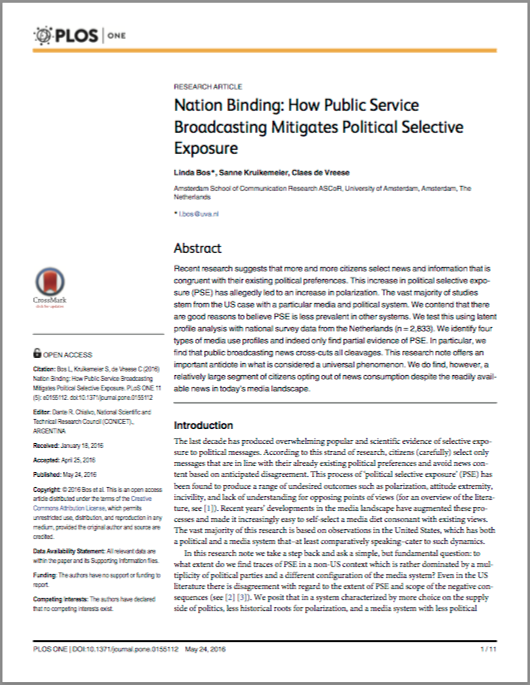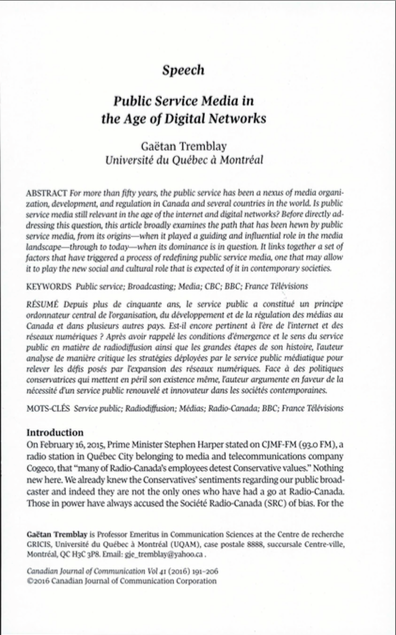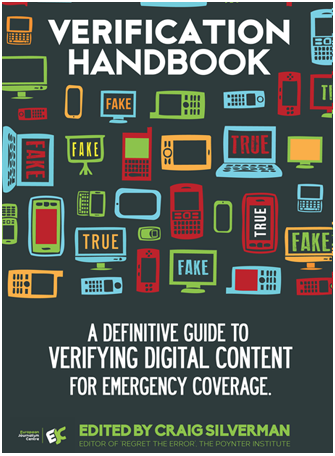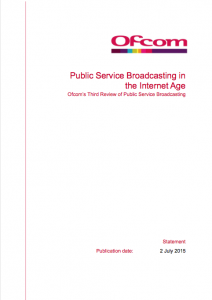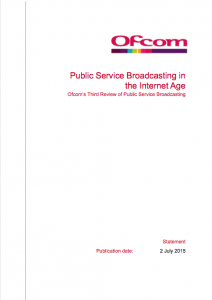Nation Binding: How Public Service Broadcasting Mitigates Political Selective Exposure
REPORT
Linda Bos, Sanne Kruikemeier, Claes de Vreese
Amsterdam School of Communication Research ASCoR, University of Amsterdam, Amsterdam, The Netherlands
(2016)
Overview
Is there a media system that promotes less political selective exposure? This article explores this question within the context of the US and Dutch media landscape, offering a comparison of the two. In particular, this article makes the case that where there is a relatively strong public service broadcaster, political selective exposure amongst an audience is lower due to its less partisan output. However, the authors do find that there is a large segment of citizens that choose to opt out of news consumption, despite its availability in today’s media landscape.
This article is Open Access, distributed under the terms of the Creative Commons Attribution License.
Ensuring public service news provision in the era of networked communications
JOURNAL
Gregory Ferrell Lowe and Alan G. Stavitsky
International Communication Gazette
University of Tampere, Finland and University of Nevada, Reno, USA, Sage Publications
(2016)
Overview
The article analyses the economic viability of news production in the two main categories of media organisations, legacy media and digital native media, with a focus on USA and Europe. Their findings encourage the development of a more comprehensive news media system that follows innovation, advocates diversity and enhance quality. The article includes proposals for media policy, partnerships, education and professionalism.
Public Service Media in the Age of Digital Networks
JOURNAL
Gaëtan Tremblay
Canadian Journal of Communication
Université du Québec à Montréal
(2016)
Overview
This article addresses the question as to whether public service media is still relevant in the “age of the internet and digital networks”? It does so via an exploration of the way public service media has evolved into what it is today and how it might be redefined to offer a culturally and socially relevant role in today’s contemporary society.
Innovation as the Key for the Future of Public Service Media
JOURNAL
Tania F. Lombao, Andrea Valencia-Bermúdez, and Francisco Campos
New Advances in Information Systems and Technologies
University of Santiago de Compostela, Springer
(2016)
Overview
This chapter looks at the effects of digitisation in the production and consumption of public media, and the changing needs for news in society. Digitisation is a challenge and call to action for public service media to innovate, develop and reinforce their position in the news sphere, as competition increases. The research specifically assesses the progresses in digital innovation which took place in public service media across Europe until mid-2015.
Making Public Television Social? Public Service Broadcasting and the Challenges of Social Media
JOURNAL
José van Dijck & Thomas Poell
Television & New Media
University of Amsterdam, Sage Publications
(2015)
Overview
This article investigates how the rise of social media affects European public service broadcasting (PSB), particularly in the United Kingdom and The Netherlands. The article explores this interaction on three levels: the level of the institution, professional practice, and content. The authors go on to explore how PSBs cope with the challenges of social media and whether it can be used to engage audiences without compromising public values.
Throwing the Switch
REPORT
An Update on the State of the Global Transition to Digital TV Broadcasting
John Burgess
Center for International Media Assistance, Washington, US
2015
Overview
With 2015 being the deadline for many countries to make the switch from analogue broadcasting to digital, the CIMA has produced this report as an update to the progress of transition. It finds that many developing countries have yet to fully benefit from the move to digital broadcasting.
Verification Handbook
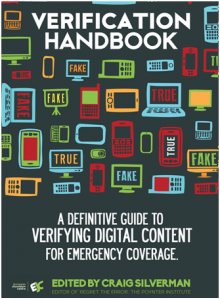
Guide
This essential resource for journalists and aid providers offers the techniques, tools and step-by-step guidelines for how to deal with user-generated content (UGC) during emergencies.
Produced by the European Journalism Centre and authored by journalists from Storyful, the BBC and Digital First Media amongst others, the handbook gives “actionable advice to facilitate disaster preparedness in newsrooms, and best practices for how to verify and use information, photos and videos provided by the crowd“.
For access to this open source publication, click here.
For more access options, click here.
Ofcom: Public Service Broadcasting in the Internet Age
POLICY BRIEF – REPORT
This document, produced by the independent British broadcasting regulator, sets out its conclusions from its third review into public service broadcasting in the UK.
It assesses the performance of the PSB system as a whole and the potential challenges it faces in the future. It also looks to the methods that could be employed to maintain and strengthen PSB across the UK.
The report is published alongside various additions and annexes which assess PSB in each of the UK’s regions and nations specifically. These can be found here.
Women and Media Industries in Europe
JOURNAL
Helsinki University
Nordicom Information 37 (2) 2015
Overview
Tarja Sovelainen offers an introductory overview of research into the progress made by the European Council in relation to the objectives set by the Fourth World Conference on Women in Beijing, 1994. This paper particularly focuses on the role of women in the media, their representation, the use of balance and stereotypes, and the access of women to expression and decision-making in and through media outlets.
Moving beyond the Borders of Top–Down Broadcasting
JOURNAL
An Analysis of Younger Users’ Participation in Public Service Media
Anne-Sofie Vanhaeght and Karen Donders
Television & New Media
Vrije Universiteit Brussels, Belgium
Sage Publications
2015
Overview
This article analyses whether and to what extent public broadcasters have been able to transpose concepts like interaction, cocreation, and participation into actual media service delivery.
The article theoretically frames this discussion, first, by defining and operationalising interaction with, cocreation of, and participation in public service media (PSM), focusing mainly on participation, and, second, by analysing the challenges that emerge from these concepts.
To read the full journal article, click here.
